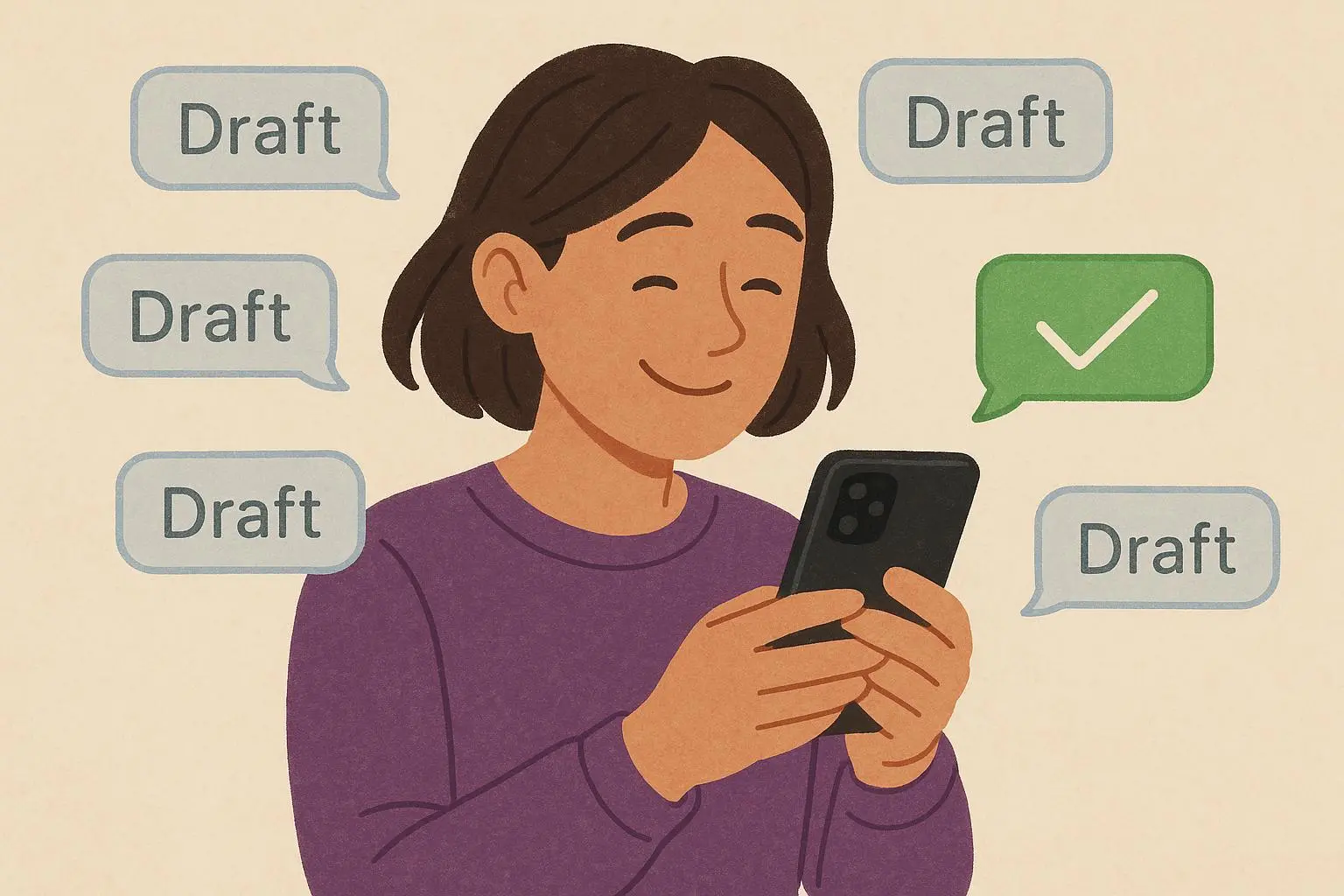
Stop Texting Anxiety: Small Shifts, Big Relief
Published on 7/11/2025 • 6 min read
Do you find yourself typing, deleting, and re-typing the "perfect" message, only to stare at your screen for hours waiting for a reply? You're not just sending a text; you're sending a piece of your anxiety with it. I know the feeling—I've spent evenings rewriting a single sentence until it felt like a tiny essay that had to single-handedly prove my worth. That strain is real, and it doesn’t have to be your default.
Texting anxiety is more common than we talk about. It’s the knot in your chest when your phone buzzes and you hope it’s not a response you’ll have to explain. It’s the phantom worry that every dot in a typing indicator is plotting a critique. This article is a friendly, practical guide I wish someone had handed me years ago. I’ll explain why this happens, how to gently change your habits, and walk you through tiny, realistic shifts that actually reduce the pressure. By the end, you’ll have a handful of tools and a new way of thinking—so your phone becomes a bridge, not a battleground.
Understanding the roots of texting anxiety
Texting looks simple, but it removes the cues humans rely on—tone, facial expressions, body language. Our brains dislike ambiguity and will invent meaning when signals are missing.
Texting anxiety is the stress tied to sending and receiving messages. For me, in college, a one-word reply once sent me spiraling for an entire day. The reality: my friend was between classes. The lesson: my brain defaulted to the worst explanation.
Three things feed the cycle:
- The communication void: without non-verbal cues, your mind fills in gaps—often with negative scenarios.
- Psychological triggers: perfectionism, fear of rejection, and intolerance of uncertainty amplify small unknowns.
- The spotlight effect: we overestimate how much others notice and judge us.
Ambiguity feels threatening. Understanding these roots is the first step—once you see your interpretations as predictable patterns, they’re easier to dismantle.
Strategy 1: Ditch perfection and set realistic expectations
One useful shift: stop treating every text like a performance. Aim for clarity and connection, not literary perfection.
People have full lives. Instant replies are a myth. Early on, reminding myself people might be cooking or in a meeting defused the urgency fueling overthinking.
Measurable outcome from my own practice: I cut my average number of rewrites from about 8–10 per important message to 1–2, saving roughly 10–20 minutes per message and reclaiming nearly an hour a day I used to lose to drafts.
Practical steps with exact toggles:
- Turn off read receipts
- iOS: Settings > Messages > Send Read Receipts (toggle off)
- Android (Google Messages): Open conversation > tap name > More > Turn off "Show read receipts" (varies by phone)
- Use a "5-minute rule." If you can’t decide in five minutes, send the clearest version you have.
These small changes reduce the space anxiety needs to grow.
Callout: Quick win mindset
If you can’t decide in five minutes, send the clearest version you have. You can always follow up.
Strategy 2: Stop decoding tone—assume positive intent
Punctuation obsession is common: a period feels cold, an emoji softens tone. Those tiny interpretations can steal hours.
Practice this cognitive reframe: when your mind jumps to negativity, consciously name three neutral or positive explanations (busy at work, phone on silent, short on time). I’ve found this cuts repetitive worry by more than half.
Concrete actions:
- Suggest a quick call when tone matters. Two minutes can resolve what hours of text agonizing won’t.
- Use emojis or GIFs to add warmth when text feels flat.
Assuming positive intent is not ignoring repeated bad behavior. If someone consistently dismisses you, that pattern matters—but for most everyday interactions, generous interpretations conserve emotional energy.
Strategy 3: Remember there's a human on the other side
Imagining the person you’re texting as exactly that—a person—helps. They have messy lives and imperfect timing. Shifting your goal from performing to connecting is kind to both of you.
Authenticity beats polished distance. I sent a clumsy joke once, then followed up with, “That was terrible, sorry.” The honest follow-up broke the tension and made the exchange more real.
Quick rules I use:
- Read your draft aloud. If it sounds like you, send it.
- Reference a shared moment or inside joke—low-stakes and warming.
When I used this mindset, my texts got simpler and conversations warmer.
When you're stuck: let technology help, responsibly
There are nights when anxiety wraps a clear thought in doubt until you can’t type. External phrasing tools can be a nudge out of the spiral—like a conversational coach showing alternate ways to say what you mean.
Disclosure: I’ve used a Social Anxiety Rewrite feature that helped me; I’m not paid to recommend it. If you prefer alternatives or want to avoid a single-tool dependency, try any of the following:
- Built-in keyboard suggestions (iOS QuickType, Gboard)
- Grammarly for short messages
- Google Messages or built-in smart reply suggestions
- Drafting in Notes or a trusted friend’s quick read
How to use tools well:
- If you’ve rewritten a message more than three times, paste the draft into a rewrite tool for suggestions.
- Treat suggestions as learning data—notice recurring edits (shorter sentences, warmer phrasing) and try to adopt them.
- Use tools sparingly to build confidence, not create dependence.
Example before/after (copy-safe):
Before: "Fine. Okay."
After: "Got it—thanks!"
Before: "Do you still want to meet?"
After: "Are we still on for coffee tomorrow?" (clear, specific, easier to reply to)
These small wording changes reduce ambiguity and friction.
Small habits that add up
Tiny routines create durable change:
- Time-block phone checks. Schedule short windows to look at messages during work or study.
- Practice short-form sharing. Send brief, unedited updates to build momentum—"Saw this and thought of you." No essay required.
- Create a cool-off ritual. If you panic after sending, breathe, wait two minutes, then decide if a quick follow-up is needed.
Over weeks, these habits cut the frequency and intensity of anxious spirals.
Handling mishaps gracefully
We all send texts we regret. Most small mistakes are fixable.
- Typo or awkward phrasing: send a short follow-up, "Oops—meant to say..." People are forgiving when you’re human.
- Left on read: assume benign reasons, wait a reasonable window, and politely follow up for important matters—"Just checking on this when you have a sec." Calm, not accusatory.
- Double texting: okay when adding new info or clarifying. Don’t double text purely from anxiety—ask if the follow-up adds value.
FAQ: quick answers
Q: What if I send a text I immediately regret? A: Breathe. Correct it briefly, be human, and move on.
Q: How do I handle being left on read? A: Give it time, assume neutral reasons, and follow up politely if it’s important.
Q: Is it okay to double text? A: Yes—when you’re adding new info or clarifying. Avoid it as a panic response.
Bringing it all together
Overcoming texting anxiety isn’t about becoming a perfect texter. It’s about letting go of perfection, managing expectations, and building kinder mental habits. These changes don’t happen overnight, but they do happen.
If I could tell my younger self one thing: people are mostly focused on their own lives, not the punctuation in your messages. Be authentic; the more real you are, the fewer moments you’ll spend trapped in analysis paralysis.
Your phone should be a bridge, not a barrier.
Start small: turn off read receipts, use the five-minute rule, read drafts aloud, and when you’re stuck emotionally, try a rewrite tool or a trusted keyboard suggestion. Over time, these small steps add up—you’ll rewrite less, save time, and enjoy conversations more.
For those curious about tools, the Social Anxiety Rewrite at rizzman.ai/download was helpful to me. If you’re trying a tool, consider alternatives listed above and choose what feels safest and most helpful for your growth. Be gentle—every small step is progress.
Ready to Optimize Your Dating Profile?
Get the complete step-by-step guide with proven strategies, photo selection tips, and real examples that work.


